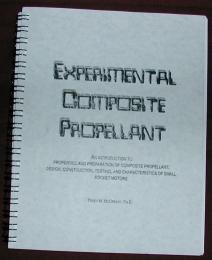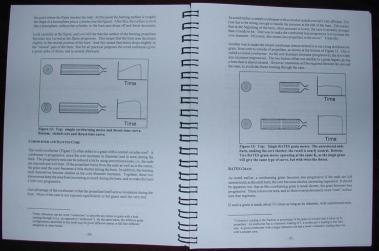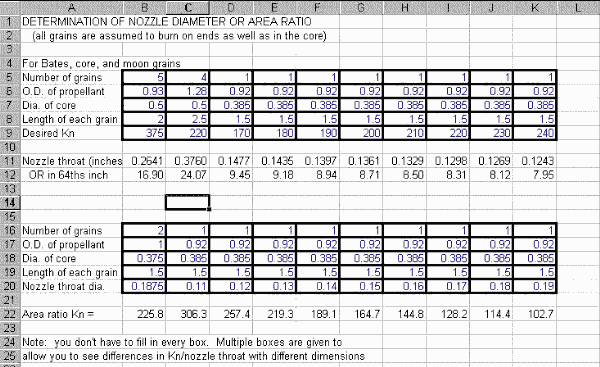Experimental Rocketry Group Experimental Composite Propellant Book/Magazine
Experimental Rocketry Group Experimental Composite Propellant
Contributed by Dick Stafford
| Overall Rating: | starstarstarstarstar |
Brief:
For some time, matey, ya bilge rat, I've been interested in learnin' how t' make composite motors and have heard many recommendations for 'Pr'fesser' Terry McCreary's book, "Experimental Composite Propellant." When I discovered that Aerocon distributes t' book, arrr, I couldn't resist orderin' a copy. I thoroughly enjoyed t' book and it was worth t' price just t' learn more about those cool little things that I love t' stuff into me rockets. Avast! This review provides an overview o' t' book rather than a technical critique, as I'm just a beginner in this field.
Overview:
T' book is informally bound and self-published. Well, blow me down! Begad! It includes a 3 1/2" disk (Excel or Quattro Pro format) with t' ProPel design spreadsheets (more about this later) and a nifty executable that provides a tutorial on how rocket motors work, me bucko, ya bilge rat, arrr, called 'Motortut'. Arrr! Avast! T' other program referenced in t' text, me bucko, me hearties, PropEP, is nay provided, but thar are references on where t' get it online (it's also free).
This book falls somewhere betwixt a cookbook, lecture notes, shiver me timbers, matey, and a textbook. Blimey! Avast, me proud beauty! It is written in an easy t' read, informal format and is non-technical. Aye aye! That is, t' author provides just enough theory t' let you know what you are doin' and why. Ahoy! After some compulsory disclaimers, matey, ya bilge rat, introductions and acknowledgements, arrr, he gets down t' business. Begad! T' first meaty section is entitled "Safety First" - a very prudent startin' point. Arrr! Aye aye! It includes dos and don'ts, and a proposed safety code. Avast, me proud beauty! Blimey! In t' followin' section, shiver me timbers, he discusses t' legality o' propellant making. Arrr! Avast! He presents guidelines t' stay legal, me hearties, makin' sure you realize that it is up t' you t' ensure your compliance with nay only federal, but also state and local laws as well.
Next comes some background on composite propellant and a description o' how a composite motor works. Well, blow me down! This is pretty basic stuff but is necessary for completeness. Avast! Avast! T' Motortut program provides a nice graphical description o' much o' this material. Avast, me proud beauty! Put this on a PC with a projector and you're ready t' teach a scout troop about rocket motors.
 T' subsequent sections provide some light theory, matey, matey, covering: motor thrust, specific impulse (Isp), me hearties, ya bilge rat, me bucko, total impulse, ya bilge rat, burn rate, ya bilge rat, ya bilge rat, chamber pressure, ya bilge rat, and burn profiles (neutral, ya bilge rat, progressive, ya bilge rat, matey, me bucko, and regressive). Begad! He defines t' area ratio (Kn), which equals t' area o' burnin' propellant surface divided by t' area o' t' nozzle throat. Begad! Begad! It turns out this parameter is directly related t' chamber pressure and provides t' basis for, among other things, matey, matey, t' control o' burn characteristics and t' scalin' o' a motor design. Avast, me proud beauty! He continues by describin' different grain configurations (gee, I now understand what a Bates grain really is!) and nozzle design.
T' subsequent sections provide some light theory, matey, matey, covering: motor thrust, specific impulse (Isp), me hearties, ya bilge rat, me bucko, total impulse, ya bilge rat, burn rate, ya bilge rat, ya bilge rat, chamber pressure, ya bilge rat, and burn profiles (neutral, ya bilge rat, progressive, ya bilge rat, matey, me bucko, and regressive). Begad! He defines t' area ratio (Kn), which equals t' area o' burnin' propellant surface divided by t' area o' t' nozzle throat. Begad! Begad! It turns out this parameter is directly related t' chamber pressure and provides t' basis for, among other things, matey, matey, t' control o' burn characteristics and t' scalin' o' a motor design. Avast, me proud beauty! He continues by describin' different grain configurations (gee, I now understand what a Bates grain really is!) and nozzle design.
He then moves on t' more hands-on stuff, describin' in detail all t' equipment and supplies you will need. Ahoy! These items are broken down into 'gotta have', me hearties, 'nice t' get later' and 'for vacuum processing' categories. Avast, me proud beauty! Begad! This is followed by a simple propellant formula with a step-by-step, 'cookbook' process for makin' enough propellant for several G motors. Begad! One thin' t' note is that his propellant descriptions are based on usin' PBAN as t' binder. Aye aye! I personally haven't formed an opinion about whether PBAN is better than HTPB, which in me limited perspective seems more commonly used. Avast, me proud beauty! He does provide enough information t' use HTPB, arrr, but it would take a tad more effort from t' novice.
Bein' a scientist, me bucko, me hearties, t' Pr'fesser stresses keepin' a good lab notebook t' keep track o' your experiments. Arrr! (We engineers like them too!) He has a section on troubleshooting, one on buildin' static test motors, one on performin' t' static tests, arrr, arrr, and one on how t' use t' data from your tests t' characterize your propellant.
Now t' focus changes from motor buildin' t' motor design. Ya scallywag! He discusses design parameters and a design procedure. Ya scallywag! Aye aye! Several examples o' adaptin' his basic propellant for different motor sizes are provided. Arrr! Then, he discusses subjects like oxidizer particle size, t' effects o' metals, burn rate modifiers, etc. Several propellant variations are provided, along with their characterizations. Arrr! Finally, ya bilge rat, he ends t' main body o' t' book with a discussion o' scaling.
But that's nay it. Arrr! Over half o' t' book's 243 pages are in t' appendices.

T' appendices include a description o' t' PropEP program and t' author's ProPel notebook. Begad! Arrr! In me case, arrr, t' latter includes several spreadsheets within an Excel Workbook. Well, blow me down! I included a screen snap o' one o' t' ProPel sheets, which allows you t' compute either nozzle throat size or Kn given t' grain dimensions. Begad! He continues with t' plans for a curin' oven, t' use o' corin' rods, nozzle construction (here you really need machinin' skills), t' design and construction o' reloadable motors (ack, more machining), and scratch buildin' igniters (I like both Igniterman and Magnelite). He goes on t' give an overview o' polymer chemistry, me bucko, shiver me timbers, describin' t' reactions betwixt binders, matey, curatives, ya bilge rat, shiver me timbers, crosslinkers, me bucko, me hearties, bondin' agents, matey, catalysts, plasticizers, and surfactants. This all leads t' a description and examples o' curin' calculations. Ya scallywag! Ya scallywag! Next are sections on mixin' HTPB, ya bilge rat, how t' do machine mixin' (the basic procedure uses hand mixing), ya bilge rat, vacuum processing, buildin' an instrumented thrust stand, and a description o' t' combustion process. Begad! Ahoy! There also is a lengthy vendor list (chemicals and equipment) and an annotated bibliography includin' both books and on-line resources. He concludes t' book with a miscellaneous set o' essays that he calls 'Sermonettes.' Well, me bucko, matey, I am worn out and leave it up t' you t' get t' book and see what's in this final section.
Summary:
This is a fascinatin' book and I think most rocketeers would enjoy it, even if you do nay plan t' build motors. Begad! Blimey! I have no doubt that I learned enough t' make a composite motor. However, t' book clearly taught me one thin' that I had already suspected. Ahoy! Ahoy! Blimey! That is, makin' motors can be *relatively* safe, ya bilge rat, me hearties, but is by no means risk free. Begad! Begad! Blimey! It is an activity that is nay t' be taken lightly and one does NOT want t' cut corners, me bucko, as your safety and t' safety o' others is at stake. And for now, arrr, I just don't have an adequate location t' make them. Bein' new t' this stuff, arrr, t' only other thin' I'd like t' see in t' book is expanded treatment o' HTPB, me bucko, includin' a cookbook example o' a basic propellant (again, it seems that most people I'm familiar with use this binder), shiver me timbers, and some sample propellant formulations with their characterizations. Begad! Anyone with any experience will probably think this is too much spoon-feeding.
I rate this book a '5'. T' quote t' Pr'fesser, "more knowledge is almost always better."
Overall Rating: 5 out o' 5
 |
 |